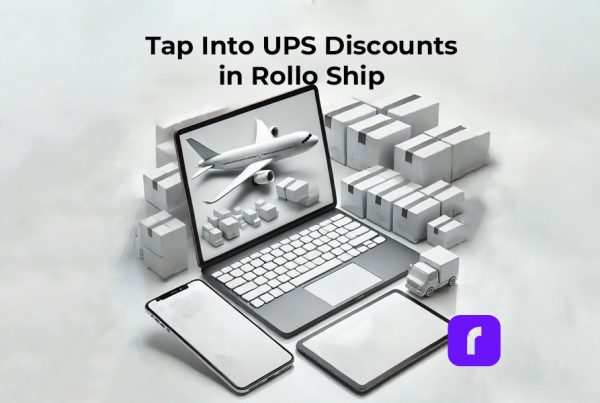For e-commerce businesses, prompt and affordable order fulfillment is crucial to success. An organized, productive shipping station is indispensable for meeting customer’s expectations, curtailing expenditures, and rationalizing labor flows. This article will explore tactics and best practices for setting up a premier shipping experience adapted to your distinct business needs.
To excel in the cutthroat e-commerce industry, productivity must be the driving force behind your logistics operations. A finely calibrated shipping station allows you to process more orders precisely in less time, diminishing overhead outlay and delays. By amalgamating thoughtful tangible arrangements with the latest software, you can transform your shipping workflow from a daily chore into a well-oiled apparatus.
Table of Contents
Tips On Setting Up Your Home Shipping Station
Many small and medium e-commerce sellers begin with a simple home shipping setup. Carving out a dedicated workspace and investing in essential equipment gets your shipping station off the ground affordably.
Space selection is critical, so choose an area with adequate room for packing materials, a printer, and organization systems like shelving. Built-in areas like spare bedrooms, garages, or basements work well.
⚠️ Keep in mind Space efficiency is crucial in a shipping station. Even in a compact area, smart organization can significantly enhance productivity. Ensure every piece of equipment and supply has a designated spot within easy reach to minimize movement and save time.
Setting up your shipping station with basic office supplies such as a desk, chair, computer, and wireless label printer is a great start. Some underrated packing essentials include a postal or industrial scale for calculating shipping weights, various box sizes, packing tape, labels, scissors, and markers.
To simplify order processing, incorporate shipping software. Apps like the Rollo app instantly bring orders from e-commerce platforms like eBay and Etsy into your dashboard, allowing bulk printing of packing slips and shipping labels tailored to each order. Integration with carriers like UPS, DHL, and USPS gives access to discounted commercial rates, of up to 90%, and shipping options right from your dashboard.
Organizing Your Shipping Station for Peak Efficiency
With your shipping station established, optimize its physical layout and technology to maximize efficiency. Proper station organization reduces errors and facilitates a smooth packing process.
➡️ Step 1: Organize packing materials into labeled areas and keep supplies stocked. Set up the printer with label sizes and have labels near scale.
➡️ Step 2: Create multiple packing zones with duplicate materials to work on several orders simultaneously.
➡️ Step 3: Use color coding and clear bins/shelves to visually organize orders awaiting completion. This prevents mix-ups.
➡️ Step 4: Automate processes like scanning barcodes on shelves, bins, and products to update inventory and order status without manual data entry.
Did you know? 🤔 Automated shipping software can reduce manual entry errors by up to 90%. By integrating your e-commerce platform with shipping software, you not only streamline your operations but also significantly decrease the chances of shipping the wrong item to your customers.
Integrating your shipping software with partner platforms (e.g. Etsy, eBay) automates otherwise time-consuming steps. When a customer purchases, your software instantly receives the order details, eliminating manual order entry. At the packing stage, software-generated packing lists and customs forms populated with product details further reduce workload.
Enhancing Your Shipping Station for Packaging
An effective shipping station streamlines item assembly, packaging, and shipping label printing. Customization is key for personalized workflows catered to your products and business processes.
Select tables and surfaces sized to fit your typical packaging needs. Add shelving or cubbies around your scale for temporarily holding items pre- and post-weighing. By centralizing your packing workspace, you reduce time wasted locating supplies scattered throughout your space.
PRO TIP: Consider a mobile cart for your shipping station if space is limited. This allows you to move your packing supplies and equipment around as needed, making it easier to adapt your workspace to the day's demands.
From an ergonomic standpoint, adjustable table heights allow comfortable standing or sitting depending on your preference. Anti-fatigue mats under your primary packing area alleviate stress on joints and muscles from prolonged standing.
Label printing integrations through software like Rollo eliminate time-consuming manual address entry. With your customer, product, and shipping details already in the system, one-click generates accurate labels every time. Thermal printers enable fast label production without ink or toner cartridges to replace.
To further customize packing, integrate shipping software with third-party platforms for generating QR codes, branded packing slips, and supplemental documentation like returns forms. Syncing order data across systems automates processes so you spend less time on administrative tasks.
Investing in the right tools and technology pays dividends in increased capacity. The ability to batch-process shipping label printing for multiple orders simultaneously is a huge time saver and essential for any shipping station. Unifying your hardware and software allows seamless integration for smooth, error-free fulfillment.
The Advantages of a DIY Shipping Station
For online businesses, making their own shipping station saves money and improves efficiency compared to using a third-party service.
Developing in-house capabilities puts you in control of the end-to-end process. By handling fulfillment yourself, you avoid paying the markups associated with third-party logistics services. For a high-order volume operation, those costs add up quickly. A DIY shipping station requires upfront investments in equipment but significantly brings down per-order overhead.
A personal setup gives you autonomy over carriers, rates, and service options. You decide the most cost-effective shipping methods for each order rather than being restricted to a 3PL’s preferred partners. Freely compare options through rate shopping within your shipping dashboard to secure the lowest rates from UPS, USPS, DHL, and beyond.
⚠️ Keep in mind The initial investment in quality shipping equipment, like a reliable thermal printer and an accurate scale, pays off in the long run through efficiency and reduced errors. Don't compromise on these critical tools.
Tracking Transparency
In-house shipping allows end-to-end tracking transparency for customers. Automated email notifications update them on package progress at every checkpoint. Plus, you have full control over branding – customizing boxes, labels, and packing slips. Personalized touches create a standout unboxing experience reflecting your unique brand.
Modify Workflows
The capability to modify workflows, surface data insights, and optimize processes on-demand is invaluable. A DIY station presents boundless opportunities for continuous improvement via low-risk experimentation. Adaptability keeps fulfillment running smoothly as your business scales.
Additionally, incorporating Rollo’s precise shipping scale ensures that your postage costs are always accurate, preventing overpayment and underpayment issues that can arise from weight discrepancies. Utilizing Rollo’s Poly Mailers offers a durable, lightweight shipping option that protects your products while minimizing shipping costs. For items requiring extra protection, Rollo’s Bubble Mailers provide an added layer of cushioning, ensuring that your delicate items reach their destination safely.
Stock up on essential Rollo shipping accessories for your station. Enhance accuracy with our Shipping!
Scale, and secure your items with our Poly and Bubble Mailers!
When estimating total costs, leverage online shipping calculators. Input key details like yearly order volume, average weight, and package dimensions. The resulting base rates, plus any specialized add-ons for your region and products give a solid baseline expense profile. Compare outsourcing to in-house fulfillment to find your greatest areas of potential savings.
Start by customizing packaging to effectively protect each order’s contents with minimal excess material and void space. Settle for ideal box, or mailer, sizes fitting your common product dimensions. Add branded elements like custom tape and tissue paper to wow customers while you’re at it.
Intelligently select protective materials that stabilize contents without over padding and needlessly inflating dimensional weight. Explore sustainable, high-cushioning options like biodegradable packing peanuts. Rigid kraft divider inserts effectively brace fragile items in place more space-efficiently than endless mounds of loose fill.
When bundling items together, arrange with purpose. Orient products side by side, minimizing height while still utilizing all available space to keep footprint compact. Group heaviest items towards the center and bottom, adding lighter goods on top to balance weight distribution and maximize volume efficiency.
Finally, always choose the optimal shipment route. Factor in delivery timelines (ground vs. expedited), origin and destination points, and hub networks along possible routes. Compare rates for each practical path to eliminate excess zones and accessorials like residential delivery surcharges whenever possible.
Best Practices for Packing Lists and Efficiency
Packing lists are the ultimate safeguard against costly fulfillment snafus. Leverage these versatile tools to streamline both domestic and international shipments.
Start by creating a standardized packing list template covering all order details: ship/bill addresses, products and SKUs, shipping service and carrier, batch numbers, and more. Customize printable files with your logo and colors. Integrate with your warehouse management system or shopping cart software to auto-populate lists with current order data.
For international orders, consult export compliance programs and prohibited item lists to identify any special documentation like NAFTA certificates or licenses needed. Research particular customs form requirements for countries you ship to regularly.
Fold and insert individual packing lists into each outgoing package. Cross-reference against contents before sealing to catch any discrepancies. For multi-box orders, clearly number each carton as “Box 1 of 3” and reiterate that on corresponding packing lists.
Enhance efficiency by generating batched packing lists covering multiple orders at once. Print these in bulk based on prepared picklists and work through fulfillment in chunks rather than order-by-order. Just be meticulous about order separation during packing.
Leverage your lists post-ship as well. Implement a verification checkpoint just before handoff to carriers. Cross-reference items against printed lists to confirm you’ve got the right stuff – a last line of quality control defense.
Selecting the Right Shipping Options for Your Business
As a savvy seller, you likely ship some combination of USPS, UPS, and DHL packages. Choosing your preferred shipping carrier on a case-by-case basis optimizes for cost and transit speed. Let’s compare their relative advantages.
For small, lightweight domestic shipments, USPS is generally the cheapest thanks to subsidized rates. Their extensive local delivery networks make them speedy and reliable for First Class Package Service up to 16oz. USPS also excels for flat envelopes via First Class Mail. Just beware of the slightly higher retail rates versus commercial pricing.
UPS Ground® is the gold standard for mid-size packages prioritizing cost and reasonable delivery times. Fast coast-to-coast transit within 5 days makes it perfect for balancing affordability and customer satisfaction. Access hubs nationwide translate to reduced zone fees. UPS rates rise with weight, so keep packages under their lowest tiers.
When speed is paramount, express shipping like DHL, UPS Next Day Air®, or Priority Mail Express® can’t be beaten. At 1-3 business day delivery guarantees even cross-country, these services are worth the premium for urgent items. Compare zones, rates and cutoff times to optimize your express workflow. Remember to maximize package density to compensate for high price tags.
Last but not least, weigh your international options. Major global players are DHL, UPS, and USPS with FedEx selectively covering certain lanes. Rates and coverage vary dramatically, so run test shipments to find the best balance of cost, speed, customs transparency and reliability on key routes. Avoid surprises by securing accurate quotes upfront.
Elevate Your Shipping Station for E-commerce!
Unlock Efficiency & Savings Instantly!
Stock up on Rollo labels and supplies for your shipping station.
Use the Rollo Ship App on your Desktop or your mobile,
compare rates, and print shipping labels from leading carriers effortlessly.
Final Words
Optimizing your shipping station is integral to the development and earnings of your online store. Thanks to unified applications and equipment answers like Rollo, you can construct an ultra-streamlined order center at a reasonable expense.
From accepting products to ultimate carrier collection, we discovered methods to organize every step of fulfillment for peak rapidity and thrift. Installing the appropriate tangible and mechanical underpinnings simplifies procedures, decreases oversights, and reveals tactical observations. This freedom permits focus on core commerce rather than quotidian tasks.
Appraise your distinctive offerings, sales platforms, and volume when designating the fitting processes and apparatus for your operation. Via attentive preparation and relentless refinement, you can fashion an entire dispatch hub heightening both purchaser contentment and income.
Prepared to take your online deliveries to the next level? Examine Rollo’s robust printing resolutions, all-encompassing logistics software, and third-party unions. Our proficient squad waits to enhance order completion productivity.
Download the Rollo app today and wield intelligent, scalable delivery to implement progress with your prospering commerce.
Follow Rollo on:
Frequently Asked Questions about The Best Shipping Station Setup for eCommerce:
📌 Q: What basic equipment do I need for my home shipping station?
📌 Q: How can shipping software improve my order processing?
📌 Q: What are some tips for organizing my shipping station efficiently?
📌 Q: What are the advantages of setting up a DIY shipping station?
📌 Q: How should I budget for my shipping station?






